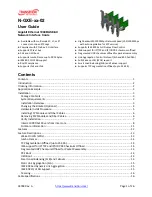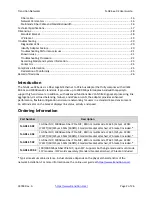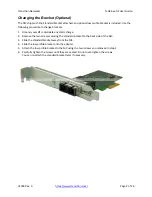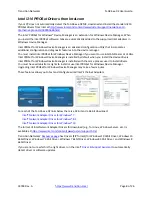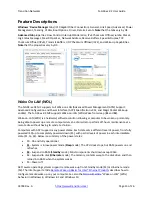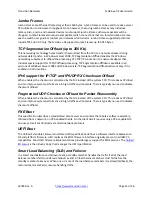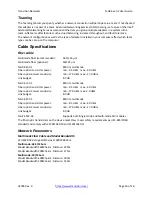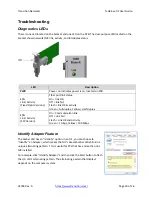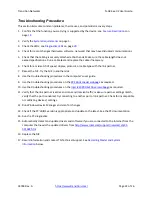
Transition
Networks
N
‐
GXE
‐
xx
‐
02
User
Guide
33748
Rev.
A
https://www.transition.com/
Page
14
of
26
Jumbo Frames
Jumbo
Frames
are
Ethernet
frames
larger
than
1518
bytes.
Jumbo
Frames
can
be
used
to
reduce
server
CPU
utilization
and
increase
throughput.
Note,
however,
that
using
Jumbo
Frames
may
introduce
latency.
Also,
end
‐
to
‐
end
network
devices
must
support
Jumbo
Frames,
otherwise
packets
will
be
dropped.
Jumbo
Frames
also
require
compatible
switch
connections
that
can
forward
Jumbo
Frames;
see
the
switch
user
guide
or
contact
your
network
administrator.
Jumbo
Frames
supported
protocols
include
TCP
and
UDP
only.
The
N
‐
GXE
‐
xx
‐
02
supports
Jumbo
Frames
up
to
9014
bytes.
TCP Segmentation Offload (up to 256 Kb)
This
networking
technology
helps
transfer
the
workload
from
the
CPU
to
a
network
adapter
during
network
data
transfer.
In
Windows
Server
2008,
TCP
Segmentation
Offload
enables
the
Windows
networking
subsystem
to
offload
the
processing
of
a
TCP/IP
connection
to
a
network
adapter
that
includes
special
support
for
TCP/IP
offload
processing.
TCP
Segmentation
Offload
is
available
in
all
versions
of
Windows
Server
2008
and
Windows
Vista.
TCP
Segmentation
Offload
will
work
only
if
it
is
enabled
in
both
locations.
IPv6 support for IP/TCP and IP/UDP RX Checksum Offload
When
enabled,
the
checksum
is
calculated
by
the
NIC
instead
of
the
system
CPU.
This
reduces
CPU
load
and
can
improve
system
performance
in
high
‐
traffic
environments.
There
is
typically
no
need
to
disable
checksum
offload.
Fragmented UDP Checksum Offload for Packet Reassembly
When
enabled,
the
checksum
is
calculated
by
the
NIC
instead
of
the
system
CPU.
This
reduces
CPU
load
and
can
improve
system
performance
in
high
‐
traffic
environments.
There
is
typically
no
need
to
disable
checksum
offload.
PXE Boot
This
specification
describes
a
standardized
client
‐
server
environment
that
boots
a
software
assembly,
retrieved
from
a
network,
on
PXE
‐
enabled
clients.
On
the
client
side
it
requires
only
a
PXE
‐
capable
NIC,
and
uses
a
small
set
of
industry
‐
standard
network
protocols.
UEFI Boot
The
Unified
Extensible
Firmware
Interface
(UEFI)
specification
defines
a
software
interface
between
an
OS
and
platform
firmware.
UEFI
replaces
the
BIOS
firmware
interface
originally
present
in
all
IBM
PC
‐
compatibles.
Most
UEFI
firmware
implementations
provide
legacy
support
for
BIOS
services.
The
Unified
EFI
Forum
is
the
industry
body
that
manages
the
UEFI
specification.
Smart Load Balancing (SLB) and Failover
In
a
Smart
Load
Balance
and
Failover
team,
a
standby
member
handles
the
traffic
if
all
of
the
load
balance
members
fail
(considered
a
failover
event).
All
load
balance
members
must
fail
before
the
standby
member
takes
over.
When
one
or
more
of
the
load
balance
members
is
restored
(fallback),
the
restored
team
member(s),
resume
handling
traffic.

